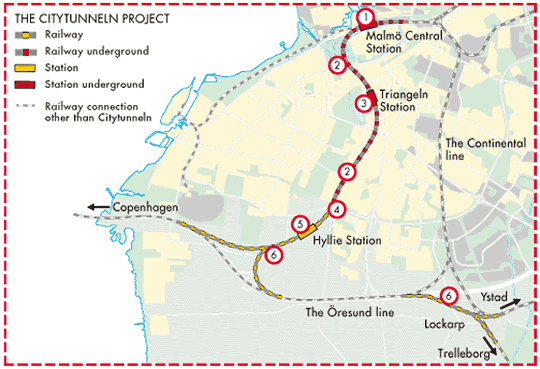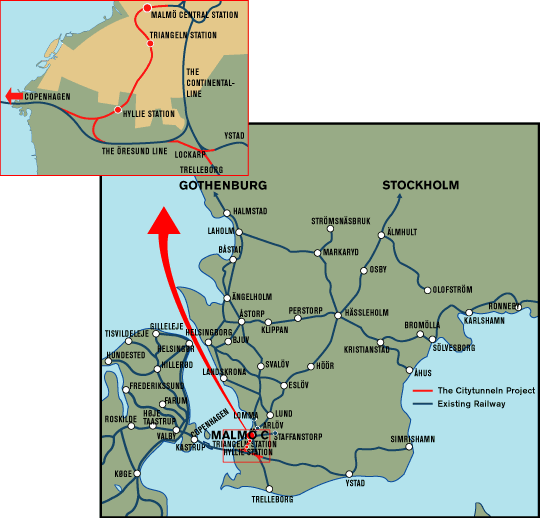The Øresund Fixed Link has opened and many of us now has the opportunity to take a momentous journey across the new bridge for the very first time.
One of the motivating principles behind the construction of the Øresund Fixed Link was to increase the use of public transport and to foster integration between Sweden and Denmark. However, the Citytunneln must also become a reality in order to fully achieve our goals.
The Citytunneln Project is the final link for rail traffic across the Øresund Fixed Link on the Swedish side of the Øresund Channel.
The Citytunneln Project will make journeys easier for rail passengers by providing more stations, fewer changes and shorter travelling times. It will also make it possible for more trains to pass through the city.
|

|
|
1. The railway yard in Malmö and Malmö Central Station
The Citytunneln Project starts with track connections from the southern main line and the Continental line. The railway yard in Malmö and Malmö C will require substantial reconstruction work in order to be able to hook up with the Citytunneln. Rail traffic will remain in operation during the entire period of construction. Therefore, detailed planning is a must and large-scale makeshift solutions may be needed.
The Central Station in Malmö will house a new subterranean station (Malmö CN) to the north of the present railway station. The station will have four tracks and two interjacent 320-meter long platforms. Proposals have been put forward to build the station in a traditional manner with open shafts. The station will have three different entrances, the Central Hall, the Petri Bridge and the University Islet.
|
2. The tunnel section between Malmö C and Holma
The underground section of the Citytunneln will run from the Malmö railway yard to Holma, which is a distance of 6 kilometres. Concrete tunnels will be built in open shafts at each end and the shafts will later be covered over by using so-called cut and cover technique. The concrete tunnels lie beneath the subsoil water level, which must be lowered temporarily.
The bored portion of the tunnel consists of two parallel, single-track tubular-shaped tunnels, bored through limestone rock, approximately 20 meters below the ground surface. The limestone rock is highly water bearing in many places. In order to avoid lowering the subsoil water level and ensure that as little water as possible is allowed to leak into the tunnel, the tunnel will be bored using a double-shielded tunnel-driving machine (TBM technology). The machine has a closed front end and is built in such a way that water is prevented from forcing its way into the tubular tunnel during the tunnel-driving phase, which can take place despite full subsoil water pressure. Therefore, subsoil water levels need not be lowered. The tunnel itself is built inside the machine as a watertight concrete pipe.
The concrete element is put in place from the rear of the machine as the tunnel driving machine moves forward. The excavated materials are removed by wagons using the same route. The joints between the concrete elements are sealed with rubber moulding so that the tunnel will be completely impermeable. However, because the bedrock is highly water bearing, it will be impossible to prevent some water from entering the tunnel along with the excavated stone material. In the event that this would entail a risk that the subsoil water might fall below acceptable levels, the water can be re-filtrated into the bedrock again.
The two tubular-shaped tunnels will be connected to safety /emergency exits. This feature will make evacuations, rescue work and fire fighting in the event of an accident easier.
The tunnelling will begin at Holma. The tunnel-driving machines will be placed in two open shafts from the mouth of the tunnel at the southern end and they will work their way north toward Malmö C.
|
3. Triangeln Station
The station at Triangeln will be right in the centre of Malmö in the shopping, housing and cultural area known as Triangeln. Approximately 35,000 people will be within walking distance of the train if the station is built as planned. Plans call for the station to be built in the form of a rock cavity some 20 metres below the ground surface. The station will have two tracks and a 250-metre long interjacent platform. The construction technique involves opening shafts from ground level and then milling out a large cavity down in the bedrock. The station will have an entrance at each end, one to the north and one to the south.
|
4. Railway Holma - Hyllie
The railway line will be above ground south of Annetorpsvägen in Holma. On the stretch that passes through the district Hyllievång, which is still in the planning stage, the railway line will continue on in open shafts, which are approximately 4-7 metres below the ground surface. This is to reduce noise pollution and facilitate the construction of graded level crossings for vehicles.
|
5. Hyllie Station
The station at Hyllie will be above ground, have 4 tracks and platforms that are 10 metres wide. The station itself will be 320 metres in length. It will be located just south of the mouth of the tunnel in the vicinity of the water tower in Hyllie.
The area is virtually free of houses and buildings at the present time, which paves the way for a wide range of development opportunities.
|
6. Connecting tracks
Rail traffic will continue from the station at Hyllie westwards toward the Øresund Fixed Link and east-wards toward Ystad and Trelleborg. A connecting railway line must be built through Lockarp in order to connect the Øresund line to the Ystad line and to the Continental line in the direction of Trelleborg.
This will make direct trains from Ystad and Trelleborg to both Lund and Copenhagen possible.
|
Contractors

The Citytunneln Project will require the procurement of two large contractors and a number of smaller contractors.
- The construction of the tunnel using TBM technology and the construction of the subterranean sections of the station at Triangeln will be a contract worth approximately 3 billion SEK.
- The construction work at Malmö Central will be the other large contract. The cost is estimated at approximately 1 billion SEK.
Plans call for the prequalification process to begin in 2001.
|
Developers
The National Rail Administration, Swedish State Railways, the City of Malmö and Region Skåne formed the Citytunnelkonsortiet i Malmö in 1997. The Consortium is a partnership engaged in planning, constructing and commissioning the Citytunneln Project.
An operational system is currently being developed to steer the project, which will be ISO certified. The environmental trials and the consideration of applications related to the project are currently in progress. The final conditions for project are also being established.

|
|